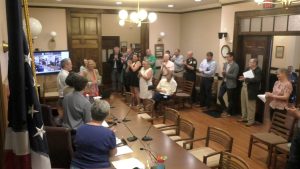Aired January 26, 2023.
New bylaws in place in Needham change the rules for clearing snow for Needham businesses and residents. We may have lucked out so far on the season, but there is still plenty of winter left to go. As New Englanders, we know that snow can happen at almost any time. What you may not know in Needham, there are new rules in place which provide requirements for businesses, non-profits and other entities for dealing with that white stuff.
Shane Mark, the Assistant Director of Public Works:
The change the bylaw came about when COVID first hit a few years ago. It’s hard to believe we’re three years into this process now. At that time where we were strongly encouraged to get outside, people wanted to get outside in the open, walk around more. That was particularly difficult during the winter. So what the town did is we took a look, trying to overlay sidewalk areas that the town owned as well as the businesses to create a map or a walkway that we could present to the public so that people knew where they could walk safely because it was cleared by the town and/or the businesses. What we found when we did that was that there were several gaps, in that the language of the past bylaw wasn’t necessarily clear in a lot of situations. So, the change to the bylaw really was intended to clarify some of those gaps and make up for that. For example, now with the bylaw, non-profits are included as part of that, where in the past non-profits weren’t included. So the way the bylaw is currently written any owner, tenant, occupant, proprietor, manager, agent, board, trust, or other entity having charge of property used wholly or in part for either commercial or non-commercial purposes, which includes as a store, restaurant, bank, gym, theater, childcare facility or office, hospitals, medical establishments, places of worship, multi-family housing containing three or more dwellings or units or any other use to the open public or clientele, the snow and ice [on that property] shall not remain on the sidewalk abutting the property for more than five hours between sunrise and sunset. So the change is really meant to allow pedestrians and people who are outside to have safe access to the sidewalks without slipping, tripping, falling, or having to walk into the street because of snow banks from where sidewalks aren’t clear. People often ask us, how wide does the path need to be? Where should I place the snow? When should I plow? What we say is, because the bylaw doesn’t say how wide the width has to be, we recommend at least clearing a width of 60 inches, and if there are any pinch points or obstructions such as a utility pole, a mailbox or other things that would limit that to a smaller area than 50 inches. In those cases, clear at least a 36 inch wide path. The reasoning behind that is we want to make sure that people or users of wheelchairs who have accessibility issues can navigate through those pinch points and can navigate along the sidewalk. This is really meant to be pedestrian-friendly, and make it easier for pedestrians to be outside and walk safely after a snow storm.
Shane Mark, the Assistant Director of Public Works:
When you’re plowing your snow off your sidewalks, please don’t put it back into the roadway. We have a separate town bylaw against that. So what we encourage residents to do is place it along the windrow, if you have a windrow in front of your house where you have a berm, a grassy area in between your sidewalk and the curb line. Put it in that grassy area, but please don’t blow it back into the street. Because by blowing it into the street, it’s counterproductive to what our plows are doing and it could also create a dangerous condition. So put it along that the berm if you have it, if you don’t have that, just get it as close to the sidewalk as possible. Just as we plow multiple times so we have to make multiple passes. Residents may have to do that with their sidewalks as well. We often hear that resident will clear their sidewalk or a property owner will clear the sidewalk only to have the plows come by and bury that sidewalk back in. I can assure you we did not do that intentionally. We’re not trying to make any property owners jobs or work harder for them, but again, when we try to open up these roadways to get as close to the curb line or the berm as possible. That snow falls off the edge of the plow and sometimes it will push it back into the sidewalks. We don’t do it intentionally at all, but we would encourage residents to try to wait till the end of the storm, when they can look at the street and see that the street’s been widened and then try to clear their sidewalks at that time.That way they’re not doing double the work. The second thing we would say is that, unfortunately, part of the plowing process is that we want to widen our streets as much as possible. We do that because we want to allow access and storage areas for future storms. If we have an eight-inch storm and we don’t plow into the curb line and then another eight-inch storm comes along, we need storage space. So we plow against those curb lines. Most importantly, our catch basins are in the curb line. We want to get into the curb line and open those catch basins up so that as the snow and ice begins to melt, the water has somewhere to go and can drain into our storm water system and not freeze up the street and have icy conditions or black ice in the town streets, which are even more hazardous than if snow were on the roadway. So those are things we’d encourage. We also publish our plan. We try to communicate as best we can via Facebook, Twitter, social media, before the storm, both through our DPW page, as well as on our website. So if anyone wants to know what our current process is or how we’re doing it, feel free to visit the DPW webpage and we have a whole page on information related to snow and ice removal and our processes. It’s a big job for the men and women who perform this work. A lot of our storms go beyond 18-24 hours. Some of those storms, as we all experience, can go to 36 – 48 hours and our workforce is out there working that entire time for safety. We’ve got the women and the men that do this work are out there for long hours behind the snow plows in the snow sidewalk machines working diligently to provide safety. So we appreciate everyone’s patience with this as we move towards our storms.
New bylaws in place in Needham change the rules for clearing snow for Needham businesses and residents. We may have lucked out so far on the season, but there is still plenty of winter left to go. As New Englanders, we know that snow can happen at almost any time. What you may not know in Needham, there are new rules in place which provide requirements for businesses, non-profits and other entities for dealing with that white stuff.
New Rules for Some
Shane Mark, the Assistant Director of Public Works:
The change the bylaw came about when COVID first hit a few years ago. It’s hard to believe we’re three years into this process now. At that time where we were strongly encouraged to get outside, people wanted to get outside in the open, walk around more. That was particularly difficult during the winter. So what the town did is we took a look, trying to overlay sidewalk areas that the town owned as well as the businesses to create a map or a walkway that we could present to the public so that people knew where they could walk safely because it was cleared by the town and/or the businesses. What we found when we did that was that there were several gaps, in that the language of the past bylaw wasn’t necessarily clear in a lot of situations. So, the change to the bylaw really was intended to clarify some of those gaps and make up for that. For example, now with the bylaw, non-profits are included as part of that, where in the past non-profits weren’t included. So the way the bylaw is currently written any owner, tenant, occupant, proprietor, manager, agent, board, trust, or other entity having charge of property used wholly or in part for either commercial or non-commercial purposes, which includes as a store, restaurant, bank, gym, theater, childcare facility or office, hospitals, medical establishments, places of worship, multi-family housing containing three or more dwellings or units or any other use to the open public or clientele, the snow and ice [on that property] shall not remain on the sidewalk abutting the property for more than five hours between sunrise and sunset. So the change is really meant to allow pedestrians and people who are outside to have safe access to the sidewalks without slipping, tripping, falling, or having to walk into the street because of snow banks from where sidewalks aren’t clear. People often ask us, how wide does the path need to be? Where should I place the snow? When should I plow? What we say is, because the bylaw doesn’t say how wide the width has to be, we recommend at least clearing a width of 60 inches, and if there are any pinch points or obstructions such as a utility pole, a mailbox or other things that would limit that to a smaller area than 50 inches. In those cases, clear at least a 36 inch wide path. The reasoning behind that is we want to make sure that people or users of wheelchairs who have accessibility issues can navigate through those pinch points and can navigate along the sidewalk. This is really meant to be pedestrian-friendly, and make it easier for pedestrians to be outside and walk safely after a snow storm.
Best Practices for All
Shane Mark, the Assistant Director of Public Works:
When you’re plowing your snow off your sidewalks, please don’t put it back into the roadway. We have a separate town bylaw against that. So what we encourage residents to do is place it along the windrow, if you have a windrow in front of your house where you have a berm, a grassy area in between your sidewalk and the curb line. Put it in that grassy area, but please don’t blow it back into the street. Because by blowing it into the street, it’s counterproductive to what our plows are doing and it could also create a dangerous condition. So put it along that the berm if you have it, if you don’t have that, just get it as close to the sidewalk as possible. Just as we plow multiple times so we have to make multiple passes. Residents may have to do that with their sidewalks as well. We often hear that resident will clear their sidewalk or a property owner will clear the sidewalk only to have the plows come by and bury that sidewalk back in. I can assure you we did not do that intentionally. We’re not trying to make any property owners jobs or work harder for them, but again, when we try to open up these roadways to get as close to the curb line or the berm as possible. That snow falls off the edge of the plow and sometimes it will push it back into the sidewalks. We don’t do it intentionally at all, but we would encourage residents to try to wait till the end of the storm, when they can look at the street and see that the street’s been widened and then try to clear their sidewalks at that time.That way they’re not doing double the work. The second thing we would say is that, unfortunately, part of the plowing process is that we want to widen our streets as much as possible. We do that because we want to allow access and storage areas for future storms. If we have an eight-inch storm and we don’t plow into the curb line and then another eight-inch storm comes along, we need storage space. So we plow against those curb lines. Most importantly, our catch basins are in the curb line. We want to get into the curb line and open those catch basins up so that as the snow and ice begins to melt, the water has somewhere to go and can drain into our storm water system and not freeze up the street and have icy conditions or black ice in the town streets, which are even more hazardous than if snow were on the roadway. So those are things we’d encourage. We also publish our plan. We try to communicate as best we can via Facebook, Twitter, social media, before the storm, both through our DPW page, as well as on our website. So if anyone wants to know what our current process is or how we’re doing it, feel free to visit the DPW webpage and we have a whole page on information related to snow and ice removal and our processes. It’s a big job for the men and women who perform this work. A lot of our storms go beyond 18-24 hours. Some of those storms, as we all experience, can go to 36 – 48 hours and our workforce is out there working that entire time for safety. We’ve got the women and the men that do this work are out there for long hours behind the snow plows in the snow sidewalk machines working diligently to provide safety. So we appreciate everyone’s patience with this as we move towards our storms.





More Stories
ZBA Deliberates Tight Fit on Chestnut Street
Envision Needham Finds Resistance
Needham Open Studios Turns 25